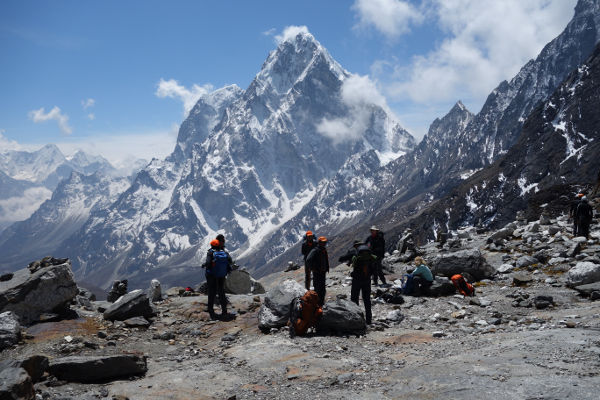Acving in groups for the EBC Trek is a whole new experince so it should be planned with great care, delight and management as there will come many who seeks this too. It all starts by getting a good group of similar-value-for-high-altitude and high-on-adventure guys who are up-to taking anything thrown their way. An understanding of the fitness levels and trekking experience in order to establish a baseline. This will help us to figure out the right pace and itinerary so we all have time at ease, yet not being bored during our journey.
The next thing you have to do is choosing the trekking season that best fits your group. The windows to undertake this journey are mostly pre-monsoon (March — May) and post-monsoon (September – November), preferable due to the amiable climate at these times. These periods see clear skies and moderate temperatures that greatly add to the trekking experience with stunning views of the grandeur-Himalayas. Once you have chosen the time, it is important to make an break-up with daily rest anth acclimatization days. High altitudes demand proper acclimatization to keep everyone safe and without altitude sickness.
The right trekking agency goes a long way in defining your experience. The agency should provide professional guides and support staff who abide by safety protocols; they will make the trekkers aware of all challenges beforehand. They may also help you to secure the necessary permits and accommodation along your route. Also have some group activities organized before the trek like a training or team bonding session, this will help your teammates know each other better and let everyone prepare physically as well as mentally.
As it gets closer to the trek, so will your packing. Mount Everest hike Each participant must have necessary equipment; warm and waterproof clothing, sturdy hiking boots and personal safety gear. One useful method is to make a common list of what each person plans on bringing along, which can help prevent over-packing by members and ensure not so commonly-forgotten items stay on board. Additionally, nutrition is a big consideration; planning meals that cater to different dietary preferences and restrictions promotes inclusivity as well as make sure everyone gets enough sustenance on the journey.
During the planning stage of anything, communication is key. Daily or weekly group meetings may help communication about what is expected, everyone’s responsibilities and potential things that could go wrong. Create a communication strategy for the trek itself: whether through walkie-talkies or group messaging apps, everyone on is kept connected and in-the-know throughout their journey.
The last important thing to remember is the fact that it allows for more adventurous adaptability. The journey to Everest Base Camp isn’t just about getting there, it’s the whole shared experience of what you do along the way. Group dynamics will change over the course of a trek, and it is best to embrace new challenges — or lighter loads. from friends who cannot continue as one gets stronger with each step in nature. This blog entry will provide a few tips to help hike leaders create the very best group experience possible, allowing trekkers with similar interests and abilities—and ultimate goals—to come together as well-bonded adventurers able to share this memory for years afterward.
Group hiking- an overview
Trekking in groups is a double whammy adventure supported by bonding and camaraderie. Put in plain words, a team of people challenged to complete the same trek through beautiful natural surroundings. The camaraderie which goes with group trekking adds to the atmosphere, as people spur each other on when faced with physical challenges. Additionally, trekking as a group can create some of the best friendships — history flows easier among those who have gone through it together! Group trekking also offers security in numbers, which is really beneficial especially when you are visiting a place like the Everest Base Camp as it may be at times unpredictable and treacherous out there.
A group trek might not be the best solution for everyone, however they can work rather well if all members have clear intentions and communicate accordingly with each other. Compatibility: Everyone should be able to talk about their own fitness levels, preferences, and what they are trying to accomplish. Part of proper planning is logistics — how one will get there, where one can stay and even what permits are needed. Organized events make it easier to participate in a group trek that emphasizes the experience of being outside, rather than worrying about the details. As such, groups can work together to construct an itinerary to suit each person from all ages and levels of ability — starting a wonderful experience that could only be cherished by everyone. In the end trekking is all about, walking together with group enjoying every trouble you face while exploring huge massive spread of nature.
Selections of Trekking Seasons
Choosing the correct season is very crucial if you are thinking of a group trek to Everest Base Camp. The best possible time in order to come for the trek is pre-monsoon (March) and post- monsoon season(September – November). These months generally have settled weather with clear skies and temperatures are not overly hot or cold which makes great conditions for trekking.
Mild temperatures can be expected in pre-monsoon season hence providing a good ground for both experienced and non-experienced trekkers. The season also brings with it a wealth of blooming flowers for an incredibly colorful setting. On the other hand, post-monsoon season is a slightly cold but clear with good visibility after the rainfall and nights are pretty cool.
Season also plays a key factor in crowd levels. Although the Everest region is popular for trekkers, it can be crowded during peak season. At the same time, a well-planned trek in these months also ensures that each member enjoys the grand outdoors without getting huge dose of crowd at every turn. Also, knowing how the weather changes by season better prepares them for any hurdles in terms of sudden changes. Groups considering the best time to trek can help maximize their experience, which will see them through memorable and enjoyable Everest base camp journey.
Who Do I Invite: Picking Group Members
One of the important things you do when setting for an Everest Base Camp trek, is to choose your group partners wisely. It is important to invite people with the same level of fitness and trekking skills. The need to be equal in physical preparedness is very important as the trek is through difficult terrains and altitude differences can put anyones endurance at test. People who love hiking and those ready for the physical challenges that come with it will ensure a good group dynamic.
Also, think about the types of people you would want to include in your groups as well. It can definitely help the process by having a positive attitude, being willing to work together and bring some fun spirit into it. It also helps to have some people around who know how to read maps and navigate easier sections, as well as first aid trained persons that can provide further assistance if needed on the trek.
Team dynamics matter as well; those who can express themselves out loud, and be good at conflict resolution are important ingredients to a harmonious environment. However, planning these group activities ahead of time can help you get a sense for how compatible and comfortable everyone is with one another. Coordinating training hikes or other team building activities can improve solidarity and get everyone in the mindset. With the right group members, it will turn into a safe zone where you that becomes one of best ever journey to Everest base camp creating some great stories for lifetime.
Setting a Budget for the Trek
Creating an Everest Base Camp budget is one of the most important steps in your planning phase. This way any costs are clear to all and evenly divided amongst those partaking, so that no one can claim the others did not pay their fair share. First think of the biggest expenses like permits, transportation to Siyeromoto, accommodation in El Nido or Puerto Princesa, food and guide services. There are permits such as the Sagarmatha National Park permit, and TIMS card that should be included in this total; you need them to legally enter the region.
Also you need to add transportation cost including flights from/to Kathmandu and domestic flight for Lukla. Prices of accommodations are very low but go up if you want comforts and amenities. Teahouses vs. more luxurious lodges can change the budget by a significant amount.
Meals are another significant consideration, as costs—particularly In remote areas —can add up quickly. Tips for your guides and porters should also be set aside. You should keep some funds aside to cover those unexpected costs: new gear, emergency situations. Not only does the group gain financial transparency but by composing a full budget, everyone know what to expect and is less likely to be surprised—freeing them up for whatever else comes their way. When people participate in setting a budget together, there is shared responsibility and awareness among the group.
How To Plan An Itinerary: Must Visit Places And Time Taken
Organising an appropriate itinerary for a trek to Everest Base Camp is key to ensuring that your walking journey goes as smoothly as possible. The trekking usually goes on for 12 to 14 days so include a couple of extra time and that will allow you plenty of acclimatization day. Create an outline with the major points along its trail — Lukla, Namche Bazaar, Tengboche and then on to Everest Base Camp. Every stop is important for acclimatization, plus a chance to meet people and enjoy some spectacular landscapes during all of those extra days.
Now that we know how long it takes, here is a suggested itinerary — taking into account rest days for altitude adjustment. For example, staying an extra day in Namche Bazaar helps us acclimatise and gives you more time to visit there and enjoy the seemingly endless vista of peaks surrounding it. The itinerary has been formatted to allow for gradual ascent which will help you acclimatize and reduce your chances of developing altitude sickness, all the while offering manageable daily distances.
You should also plan side excursions, like a day hike up Kala Patthar for panoramic Everest views or visiting Tengboche Monastery to experience some of the local culturemojompub. An ability to switch up the itinerary based on weather, or how your group responds. Fielding the same itinerary during a weekly group meeting ensure that all team members are in alignment and can make decisions based on their individual preferences. Alongside the obvious advantages of enjoying a more well planned trek, successfully promoting shared adventure and helping make everyone feel a sense of accomplishment.
Selecting a Trekking Agency, or Not
Choosing the right trekking agency or a guide plays an important role when it comes to planning your successful hike in Everest Base camp. A good operator will greatly improve the experience by supplying experienced guides, support logistics and safety features. How To Choose Best Service Agency Search for agencies endorsed by those who already had their Everest Base Camp trek. Their certifications and any affiliations with notable trekking organizations may also give you assurance of their credibility and professionalism.
Think of how many people they usually deal with. This might be a better option for larger groups as the total freebie pool will be huge, however smaller groups may find it more personal in townhouses et al. Talking about the safety protocols of the agency and how they acclimatize their trekkers will give you some idea how important our health to them. Also ask about the team of supportive staff who are most important in adding to the experience and ensuring you have an ‘+excellent’ time.
Talking about the plan for that day as well, and but also how flexible they are if weather shifts. It is key to ensure all costs are communicated clearly, and that the package outlines what comes under this cost so there are no surprises with money. Trekkers can make sure that their journey to Everest Base Camp is well-organized, safe and enriching one by choosing a good trekking agency or guide.
Physical Fitness Prep
Trekking to Everest Base Camp is something that you need to physically prepare for if you want a good trek. It is an arduous journey requiring hours of trekking and dealing with the harsh mountain climate in high altitudes. A well-developed training program should start as many months in advance. Stamina can be improved by including cardiovascular exercises (running, cycling or swimming) Plan on three or four sessions a week and build up the intensity as you go.
You do need to make sure you are adding in strength training — specifically for the legs, core and upper body. Doing things like squats, lunges and planks will help increase your overall strength making it easier to carry a backpack or walk on rocky paths. Training with flexibility (yoga or stretching routines) will increase the range of motion and decrease risk for injury.
Simulate trekking conditions. No this one is actually a blessing in disguise, because you will be putting your anti chaffing theory into practice and we can confidently say no Ragley has ever come away from their Summit Saying “I really struggled with the old inner thighs today” Think of doing longgg hikes with a weighted backpack to get used some what you could expect in terms of physical hardship on the trek. Phasing up the weight will allow time for your body to adapt from carrying 9 pounds on day one, moving all of that back to 18 by the end. Another critical habit to adopt is doing hikes at higher elevations if it’s feasible, so that you can also acclimatize yourself in thinner air. Boosting your physical conditioning ensures that you are well-prepared for the beautiful landscapes and exciting company, helping to truly get ignited by the magic of this trek.
Key Gear and Packing Recommendations
Packing the proper gear for an Everest Base Camp trek is a prerequisite to safe, comfortable walking throughout your hike. First thing first (though fairly redundant), high quality, contoured trekking boots are the most important for wandering through rough landscape. Break them in before the trek; so you don’t get your blisters! Bring moisture-wicking base layers, insulating mid-layers and waterproof outer layers; layering is essential for dealing with changing weather conditions.
You will also need a good cold weather bag and pack, as well as trekking poles to help keep you upright. Remember things for the body (eg sunscreen, sunglasses) and a basic first aid kit Both systems are OK, so pick according to your taste of a purification system however you have no exception when it comes down to hydration; bring water only or here is what that means: Water Purification System/tablets and Reusable bottles/water bladder.
Where organizing gear into categories comes incredibly handy, is packing. Use packing cubes or dry bags to keep things neat and moisture free. Try to bring the most minimal of everything, and in similar fashion to choosing a reducer material that you will use on more than one pot. I definitely do not want to forget anything, and like we have covered before going dry is not only dangerous it can make the pack cumbersome. And of course make sure to also check the weather forecast!I hope this list helps you out in your own trips, and rather than spending too much time worrying about what clothes will be appropriate where. When trekkers have the right kind of gear and are carrying less in their backpack, they can get a lot more from this unforgettable trek to Everest Base Camp.
Comprehension of Permits and Regulations
Pack of more than just Nepali currency for Everest Base Camp trek: One of the very most important aspects when planning your journey to the expedition is getting all necessary permits and understanding about appeasement; even what you are not allowed. The trek is done by taking two main permits: Sagarmatha National Park permit and TIMS (Trekkers’ Information Management System) Card The permit for the Sagarmatha National Park includes entry to Mount Everest and many endangered species. It provides a safety net for trekkers, so that the trekking authorities can trace them in case of an emergency and possibly even rescue them.
These permits are usually sold through trekking agencies or directly at specific offices in Nepal. You should definitely verify the latest rules and pricing as it could have changed since this post was written! By getting your documentation in, passport copies and photos sorted you can make the process a lot quicker.
Similarly knowing the land use and local regulations is of prime importance. Local community and personal etiquette is abided by cultural norms and environmental guidelines. This results in collective well-being to trekkers, guides as well as these local communities. This is a fragile area; groups should take care to not impact soils and ecosystem woven into the landscape by following “leave no trace” benchmarks for low-impact use. Knowing the permit requisites and rules can help you to have an even more pleasant trek, while helping in your development as a responsible traveler —helping also preserve this breathtaking area for other future travelers.
Group Functions 🦸♂
Proper Role DistributionSo this pretty much leads to my example earlier, where he organized everything and then leave it up in the air not knowing what trekking group would be established only with people who registered. If each member has a clearly defined purpose based on their knowledge and strength, then they will be able to work together well. Designate one person in the group to help with planning, scheduling and communication throughout the trip This individual is the central contact person for this trekking agency, to make sure that all of us-on track.
It is also worth appointing a navigator, particularly if the place has intricate trails. He will be able to help with route planing and keep the group on track. Roles such as “The cook” or the first-aid officer exist so that basic tasks can be handled well enabling everyone to contribute and help in their success together.
Promoting open discussions surrounding ownership is crucial; this creates a sense of responsibility and alerts the team to any issues before they spiral out of control. Checking in with each other along the trail can also give you a chance to reevaluate roles and make changes if necessary. This helps reduce any confusion in roles and collectively benefits mutual harmony within the group resulting a better overall experience of your trek, where everyone has atleast an ounce feeling towards contributing to common well-being.
Health & Safety Concerns
Group Trek to EBC – Importance of health and safety A challenging environment, high altitudes and unpredictable weather force a whole-site approach to keep all delegates healthy in such conditions. The crucial step for trekkers: a health check to ensure its participants are healthy and fit enough before flying anywhere, as well as detecting any potential problems beforehand. The team should be informed about altitude sickness and symptoms, acclimatization & prevention by gradual ascent to hight altitude & hydration.
Having an ample first-aid kit with essentials for minor injuries, altitude sickness medications and personal prescriptions are essential. Any member of the group may be appointed to manage first aid, but this will help guarantee a rapid response in case either you or a companion requires more medical attention. Also knowing the nearby medical facilities in along with way increases mental relexation.
During a crisis, such crucial communication is necessary — if you live in the middle of nowhere that [-]: Having a guide may make trekking safer in the event that people need to be evacuated. By adding regular check-ins and a buddy system, groups provide assistance to their peers in order to create accountability. Putting health and safety first, the team can face the test that is trekking to Everest Base Camp with confidence for an adventure of a lifetime.
Trek Communication Plans
A strong communication plan is important for the success of a group trek to Everest Base Camp. The importance of good communication is that it keeps everyone aware, secure and part of the journey. Agree on communication methods before embarking, i.e., using walkie-talkies or mobile phones/Messaging App suits better in case of a lack of connectivity to remote areas.
Group check-ins: Group members should be required to attend regular virtual group video chats for information sharing, Q&A and visibility on teammates’ wellbeing. There will be daily briefings at the end of each trekking day to discuss the life upon trails and mountain for tomorrow, weather conditions due treks or any other changes which require in further days.
Promoting formal communication, there can also be an informal environment where the group members feel free to express their opinions and emotions. This is especially useful when dealing with things like tiredness or altitude sickness. A well-thought communication plan will help the group to make sure that everyone is supported and knows what they need, which improves even more the trekking experience.
Pre-Trek Team-Building Exercises
Doing team-building activities before you embark on the trek to Everest Base Camp improves group dynamics and creates a bond among those who are participating. It is through these activities that you can break the ice, otherwise it becomes difficult for anyone to open up at a later stage during while out on treks.
So maybe arrange to go on a few group hikes, or sign up for some fitness challenges miles that will prepare you for trekking. This serves not just as their physical preparation but also helps members to know where each other is at in terms of form and responsiveness, so that there are people waiting for the last man standing. Some icebreaker games or group discussions can reaffirm relationships and help members to share their more personal thoughts, insecurities.
Moreover, organizing social events or trekking prep workshops that will provide useful insights at the same time create an ambiance. It is these activities that help acclimatize the individuals to each other, all around a similar set of interests and objectives propelling towards collaborative spirit which will reflect in actions during trek days. Through the practice of team-building activities, time is invested hoping to set themselves off on a good foot which is an important point when it comes to making yourself prepared for live days with fun while going up the Everest Base Camp.
Conflicts and Challenges
Undeniably, conflict resolution is critical to any team that sets about a trek in the direction of Everest Base Camp. As the trip is physically exhausting, stress and tiredness can cause some group members to get in conflict or misunderstand each others. Clarity is key, and establishing clear lines of communication will temper the flames in future conflict. Open dialogue can further enable participants to voice concerns, feelings; nurturing respect along the way.
Have someone ready to be in the middle of all us — a mediator: Someone who can get people talking and resolve conflicts quickly, logically. What this person can do is assure that everyone will be heard and a solution can then be composed together. Behavioral rules, like respecting opinions and having a positive attitude also help prevent conflicts.
When challenges come to the rise, how one confronts them is also of utmost importance. Unchecked, these problems can become the basis for resentment and a deepening divide. They may have lost perspective on the mutual goal of reaching Everest Base Camp, instead regarding other as rivals — a situation that can be rectified by first asserting (really) forcibly; and repeatedly emphasizing massively shared teamwork with ALL (! New skills for resolving conflict and developing a shared understanding of culture within the group help tackle problems in order to grow close together, make good memories on our laughing-stalking-bear-arcane path.
Now Gather Your Friends, Let’s Finish Together
Taken together, the group experience on a trek to Everest Base Camp provides endless reasons why you should embrace every bit of it. The collective struggles, precious views and dawning of victory become memories that you will savour long after the trip ends. Strong bonds that trekkers share amongst each other, as they trek through tight trails and high passes together give the whole thing a more collaborative approach which in turn results on making everyone journey of growth simultaneously with falling in love with nature.
Through preparation, communication and problem-solving before problems arise in the field or on the mountain anyone can survive high-altitude trekking with confidence and camaraderie. I love the fact that everyone brings something unique, which in turn enriches my experience and helps me feel more appreciated for who I am. The camaraderie developed through mutual encouragement helps participants to do the trek both emotionally and if necessary, even physically.
Reaching their destination and forging new connections along the way, Everest Base Camp is more than just a physical details; it involves taking on challenges head-on, as well as appreciating the natural beauty surrounding us. When trekkers do this, they turn an arduous trip into a life long friendship and accomplishment fest.
Keep an eye for more news & updates on Zol Trakk!




